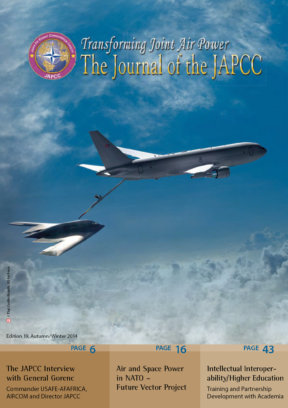Editorial
‘Our Alliance now faces the increasingly dire risk of not having the right capabilities and / or sufficient quantities of air power and access to space capabilities to cope with the security challenges outlined in NATO’s forward looking Strategic Concept.’ – This is a quote from General Frank Gorenc, out of the foreword of the JAPCC study ‘Air and Space Power in NATO – Future Vector’. It refers to the lengthy run of defence cuts over the last decades and the diminishing Air and Space Power capabilities as a consequence. Around NATO’s European border, the world is more or less on fire and NATO is lacking Air Power capabilities to deal with the challenges that lay ahead. The Alliance as a whole must act now to be better prepared for the future. The steady decline of defence expenditures needs to be stopped or reversed and the actual spending should be well thought through. Investments should be directed at alliance shortfalls, rather than fulfilling national requirements. More specifically, NATO’s European Member Nations need to ensure that there is a set of full spectrum Joint Air and Space Power capabilities available within these nations to conduct an operation without relying fully on US support. If the NATO Nations do not solve this issue, Air Power will continue its downward spiral relevant and will no longer be in a position to play that pivotal role in safeguarding the security of the Alliance.
This is my first contribution as editor of the JAPCC Journal. 1 September, my predecessor, Air Commodore Tom de Bok, retired. I wish him all the best in retirement!
It’s my pleasure to open the 19th JAPCC Journal with an interview with our Director, General Gorenc. His view on various Air and Space Power topics can also be seen as an introduction to the 2014 JAPCC Joint Air & Space Power Conference (18 – 20 November 2014 in Kleve, Germany). This year’s Conference theme is focused on the Future of NATO Air & Space Power and is built upon the outcomes, recommendations and key messages derived from the ‘Air and Space Power in NATO – Future Vector Project’ conducted by the JAPCC. Furthermore, in this edition of the Journal, we offer you an insight into the project in which Italy, the European Defence Agency and the Movement Coordination Centre Europe worked together closely in developing and executing a process for collective AAR clearances on existing and future AAR platforms. In the article on Battle Management / Command and Control (BMC2), the author discusses the importance of an airborne early warning and control asset as a suitable platform to provide responsive BMC2 capability which significantly increases the capability, flexibility, lethality and responsiveness of joint operations when integrated with other elements of the NATO Air Command and Control System (ACCS) and JISR systems.
Other articles cover topics on Cyber, Force Protection, Language Skills, Europe’s Strategic Airlift Gap, Sea-Based Air Power, possible shift in the field of Close Air Support, Unmanned Cargo Aircraft and Manual Simulation Systems.
Finally, I would like to thank all the authors for their contributions, and add that the JAPCC team greatly appreciates your feedback and thoughts.
Madelein Spit
Air Commodore, NE AF
Assistant Director, JAPCC








